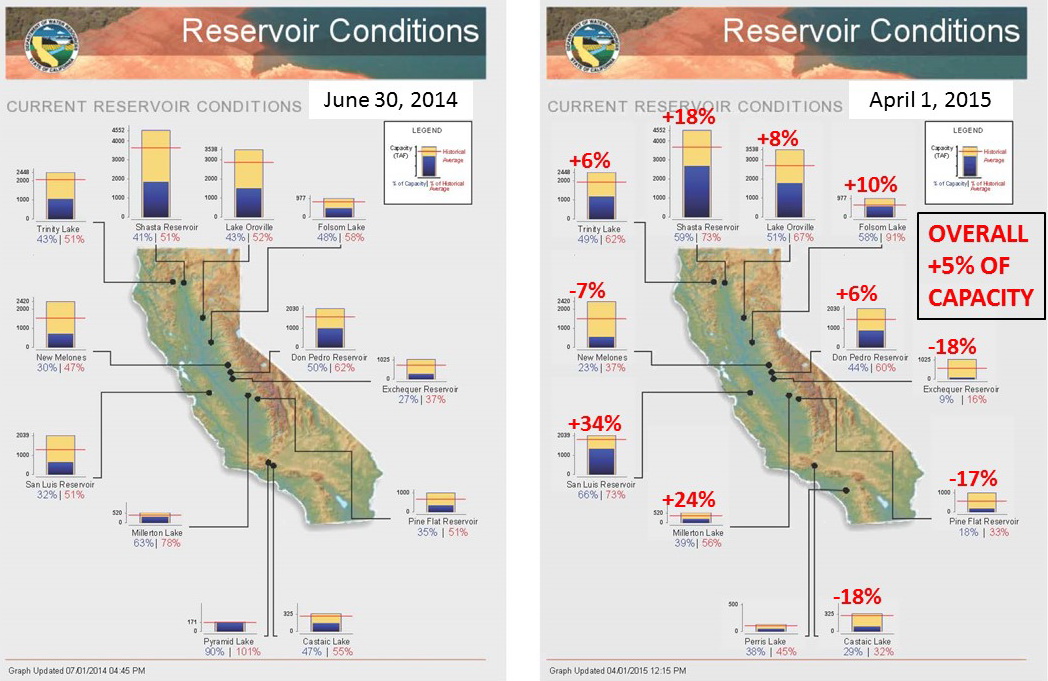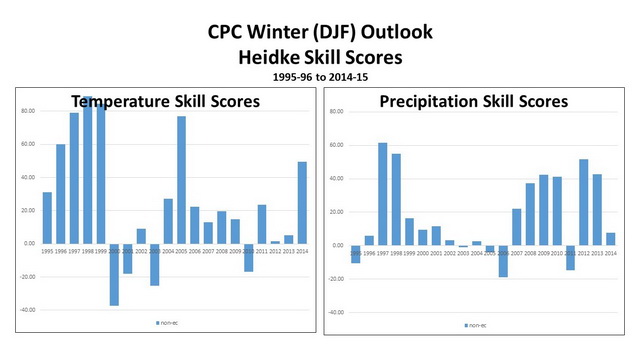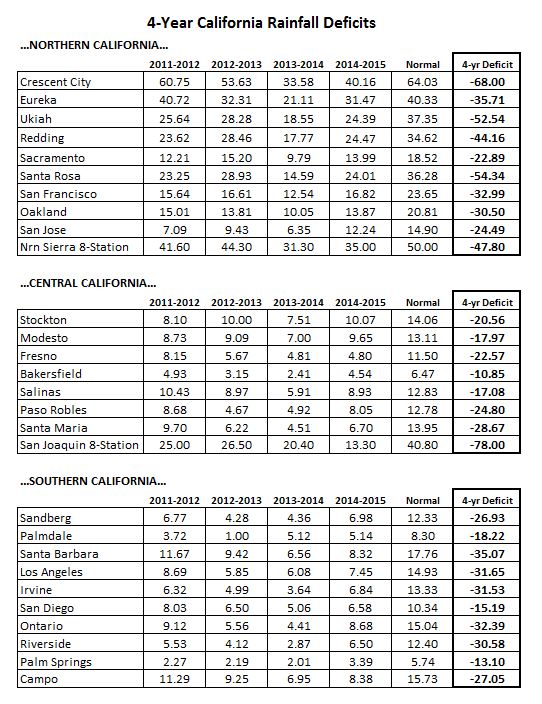Meteorologists are singing the Supreme's 1967 song "You Keep Me Hangin' On" as the current weak El Niño just won't go away.
The recent rains have prompted questions about "what does this mean for the drought" in California. The short answer is that while every inch of rain helps, the deficits over the past 4 years will not be easily mitigated.
The total 4-year deficits from normal, range from about 1 to 1.5 seasons worth over Northern California, to between a 1.5 and 2.0 season deficit in the central interior, while generally south of the Tehachapis there is a 2 season deficit. This means that for a location with a 1.5 season deficit to erased next year, that location would need 250% of normal rainfall.
Note: The 2014-15 totals above only reflect rainfall through April 5th and any additonal rainfall between now and the end of June would go toward reducing the deficit.
An even more important caveat to the above is that this table is based only on rainfall deficits while drought mitigation for California is further complicated by a host of other factors including reservoir levels, groundwater levels and water usage.
Jan Null, CCM
Golden Gate Weather Services
The latest snowpack numbers are in and they continue to be dismal; BUT the total amount of water in the major reservoirs around the state is actually 5% higher than July 1, 2014 (i.e., after most of last years snow had melted).
This is dichotomy is largely due to the high water content of the relatively warm December and early February storms and the runoff reaching the reservoirs sooner rather than later. It was further enhanced by the focus of the storms being over Northern California where there are the largest reservoirs. The three largest California reservoirs, Shasta, Oroville and Trinity, saw the greatest increases with +18%, +8% and +6% respectively.

There are a number of caveats to consider in putting this into the larger context of the ongoing California Drought. First, there will be some useage between now and July 1st so the differential will shrink if comparing July 1st to July 1st. Second, and most important, the quantifying of drought is more than just snowpack or reservoir storage; it also includes groundwater supplies and useage.
Jan Null, CCM
Golden Gate Weather Services
http://ggweather.com
March 2015 was dismally dry and way too warm across California. Most stations' rainfall was in the bottom 10 years for their period of record and temperatures smashed average monthly maximum records.
City stations in the middle part of the state had March percent of normal (PON) readings in single digits; from 3% in Fresno to 7% in San Jose and Sacramento. It was marginally better to the north and south with PON's that ranged from 24% at Redding to 61% at Eureka, while LA and San Diego had 36% and 51% respectively. (http://ggweather.com/calif/mar2015.htm)
This also meant that the seasonal rainfall picture continued to slip with season-to-date PON's (http://www.wrh.noaa.gov/mtr/rr4.php) generally in the 70% to 90% range, though Fresno trails far behind at only 49% of normal. Many of these number are however better than even the end of last season values (http://ggweather.com/ca2013rain.htm) due in large part to an exceptionally wet December.
It is also important to note that despite the dire single digit snowpack numbers, the amount water that got into the reservoirs from the warm December rains probably resulted in more acre-feet of storage into the reservoirs than if those same storms had been colder with more snow.
The March temperatures were beyond toasty, with six of the eight key cities having all-time March monthly maximum temperatures (and also some monthly average temperature records). The monthly anomalies ranged from only 1.7 degrees above normal at Eureka to "just" 5.6 above normal for San Francisco to blazing 10.1 degrees above normal at both Redding and Sacramento. (http://ggweather.com/calif/mar2015.htm)
March 2015 Average Maximum Temperature Records
- Redding 74.6 (previous record 74.3 in 2004)
- Sacramento 74.9 (previous record 72.6 in 2004)
- Fresno 77.7 (previous record 72.2 in 1972)
- Los Angeles 79.1 (previous record 75.4 in 1988)
- San Diego 74.2 (previous record 72.1 in 1959)
Jan Null, CCM
Golden Gate Weather Services
http://ggweather.com
The total rainfall in San Francisco for January, February and March 2015 is just 1.59"; the lowest in the 165 years that rainfall records have been kept. The previous record was from 2013 when there was 2.31". The March monthly total is 0.12", the fourth lowest in SF history.
At other Bay Area locations:
San Jose has their 3rd driest JFM total with 1.94". The record driest is 1.61" from 1972. (Records began 1875)
Santa Rosa has their 3rd driest JFM total with 4.44". The record driest is 3.74" from 2013. (Records began 1903)
Livermore has their driest on record JFM total with 1.77". The previous record driest was 1.83" from 1972. (Records began 1903)
Santa Cruz has their 2nd driest JFM total with 3.36". The record driest is 2.66" from 2013. (Records began 1893)
Jan Null, CCM
Golden Gate Weather Services
With the severe weather season beginning to crank up I have updated a number of resources pages. See
Thunderstorm and Tornado Resources 2015 - http://ggweather.com/tornado.htm
Hurricane Resource Page 2015 - http://ggweather.com/hurricane.htm
2015 California & National Fire Weather Forecasts and Links - http://ggweather.com/firewx.htm
Please let me know of any corrections, additions or comments to make them better.
~~~~~~~~~~~~~~~~~~~~~~~~~
There's an excellent new "animated streamline" map that has the ability to display GFS forecast streamline maps, plus current observations and forecast plus nearby webcam. See https://www.windyty.com.
~~~~~~~~~~~~~~~~~~~~~~~~~
All of these, and many more links are on the Meteorologist's Links Page - http://ggweather.com/home.html
I am also tweeting out these and other weather-related information. My Twitter handle is @ggweather
A recent CPC blog post said: "We recommend that you track the verification skill scores over time (not just for one forecast), as they give you a feel for whether you should trust them or not. Any individual forecast could hit the mark or be way off". Consequently, below are the CPC seasonal forecasts for winter for the past 20 years. It is left to the reader to assess how "skillful" these outlooks are.
For the full breakdown see http://ggweather.com/cpc/verify/cpc_winter.htm

Jan Null, CCM
Golden Gate Weather Services
http://ggweather.com
Is the date and time of a full moon called the "offical full moon" or the definition of "pi" called the "offical value of pi"? So, why do so many call the Vernal (Spring) Equinox, which occurs today at 3:45 pm pdt (2245 utc/gmt), the "official" beginning of Spring. It is simply an astronomical event that defines when the plane of earth's equator passes the center of the sun causing the earth's axis to be perpendicular to its orbit around the sun. It is not a weather event and no one or no agency issues a proclamation making it "official" anyway.
And meteorologically, Spring is defined as the months of March, April and May.
Jan Null, CCM
Golden Gate Weather Services
http://ggweather.com
As I have done in recent years, I went back and looked at how good or bad the forecast from the NWS/CPC was for the just finished winter (December, January, February). While there were some hits, but a couple of colossal fails dominated. For the second year in a row the Outlook was for above or near normal temperatures in the Northeast! NOT! And the precipitation forecast was for above normal rainfall across the southern two-thirds of California. NOT!
For the details see http://ggweather.com/cpc/2015/


Too little, too late?
CPC has upgraded their El Nino Watch to an El Nino Advisory <http://www.cpc.ncep.noaa.gov/products/analysis_monitoring/enso_advisory/ensodisc.html>, but with only a 50-60% chance it will persist through summer. The upgrade is despite the ONI dipping from +0.7 to +0.6. <http://ggweather.com/enso/oni.htm> and during a time of year when the influences of El Nino are waning.
An excellent analysis of these potential impacts can be found at http://www.climate.gov/news-features/blogs/enso/march-2015-enso-discussion-el-ni%C3%B1o-here.
Jan Null, CCM
Golden Gate Weather Services
http://ggweather.com

